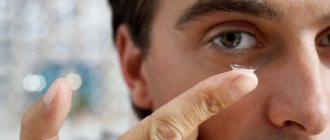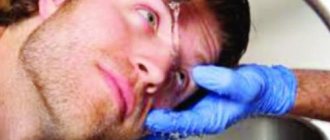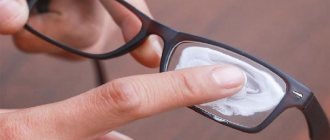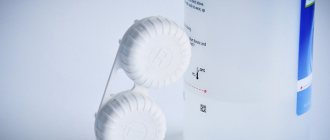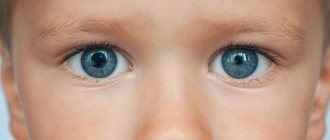Contact lenses allow you to go without glasses throughout the day. It is more convenient to play sports, work, swim and relax with them. But they cannot be worn around the clock. Ophthalmologists recommend not to exceed 16 hours of continuous wear. The thing is that regular or colored lenses are made of hydrogel, which allows oxygen to pass through only when the eyes are open. And during sleep they are in a closed position. Let's figure out why you can't sleep in contact products and what to do if you do fall asleep.
Why is it dangerous to sleep in contact lenses?
It can be dangerous to sleep in lenses that are not intended for this purpose, that is, to violate the wearing regimen specified by the manufacturer (daily or extended). It is also very important to follow the replacement period and all rules for lens care. Neglect can lead to complications and eye diseases.
Most brands are for daytime wear and are the most popular among users. This means that they are put on in the morning, worn for about 12-14 hours a day, and taken off in the evening. If they are one-day lenses, they are immediately thrown away, and lenses with a longer replacement period are put into a special container with a fresh portion of a multifunctional storage solution to be cleaned and disinfected overnight.
They should be replaced with a new pair strictly according to the manufacturer’s recommendations (usually every day / every two weeks / every month / every three months). But many tend to violate these deadlines, allow daytime naps, or even do not remove lenses at night, which can be dangerous for vision and eye health.
Whether it is possible to sleep without removing your lenses at night is determined first of all by the manufacturer. This, in turn, depends on the material from which they are made.
Choose your lenses correctly
During a visit to the doctor, it is necessary to inform about the intended use of contact optics: for sports, for office work, for frequent business trips or hiking trips. This information is important to the specialist along with the indicators of your visual acuity and the characteristics of the general condition of the visual system. Depending on the data received, a contact correction product with the most suitable service life and wearing mode will be selected for you.
Please note: the shorter the lens replacement period, the safer they are.
Hydrogel
Intended exclusively for daytime wear .
They have a certain level of oxygen permeability, moisture, resistance to bacteria, fungi, and the formation of protein deposits. But due to the properties of the material, the cornea will not receive enough oxygen during sleep, which will negatively affect its metabolism. In addition, your eyes will experience dryness. Surely many of those who still sleep in lenses not intended for this purpose have discovered redness, itching and other unpleasant symptoms the next morning. If they are regularly left on the eyes overnight, dangerous inflammatory reactions can occur due to bacteria and protein deposits.
Features of use and indications
Previously, only myopia was corrected with hard lenses. Today, indications for orthokeratological correction can include various refractive errors. Night contact lenses for vision correction have no age restrictions and can be used in the elderly as well as in children.
The schedule for wearing night lenses is determined by the doctor. Typically, orthokeratology products are recommended to be worn for 6-8 hours every other night or every night. Moreover, in the first days of wearing, vision is restored by 70-75%, and only after 2 weeks - by 100%.
High quality vision after sleep in OK lenses lasts from 24 to 72 hours.
Optimal parameters at which 100% correction is achieved:
| Disease | Degree of refractive error (diopter) |
| Myopia | Up to -6.0 |
| Farsightedness | Up to +3.0 |
| Astigmatism | Up to -1.75 |
Myopia
For myopia, orthokeratology is the optimal correction method. For a person with myopia from -1.5 to -6 diopters, complete vision correction is possible with the help of hard night lenses. Moreover, specifically for myopia, orthokeratological products have not only a correlating, but also a therapeutic effect. Unlike glasses and regular lenses, they slow down the progression of the disease - a problem that is especially relevant for children and adolescents.
Farsightedness
Previously, hard lenses were not produced to correct farsightedness, which is associated with the very mechanism of hyperopia development. With farsightedness, unlike myopia, in order to correct vision, you need to make the cornea not flat, but, on the contrary, more convex. This can be achieved by increasing the pressure along the periphery and decreasing it in the center. But, in this case, blood circulation and nutrition of the cornea, and the circulation of tear fluid are disrupted.
Such side effects have been minimized, and hard lenses for the correction of farsightedness have recently appeared on the market. They have a complex structure, but lower correction capabilities (up to 3-4 diopters). It is very difficult to obtain such lenses, since not all manufacturers of orthokeratology products produce them. In addition, OK lenses for farsightedness are much more likely to cause side effects and complications.
Age-related farsightedness (presbyopia) in people over 40 years of age is very difficult to correct with hard lenses. But positive results can be achieved only in the initial stages of pathology development.
Astigmatism
Astigmatism, which develops with curvature of the cornea and is combined with myopia, is corrected with hard lenses for minor impairments, the values of which do not exceed -1.75 diopters. However, choosing the right lenses to correct astigmatism is much more difficult than in the case of myopia.
Strabismus
OK lenses are effective in cases of divergent strabismus that occurs against the background of myopia. In such a situation, it is sometimes possible to eliminate the problem without resorting to surgery. If the problem has developed due to farsightedness (convergent strabismus), hard lenses will not help.
If strabismus is caused by injury, nighttime eye lenses will help correct myopia (if present), but will not cure strabismus or other vision problems.
In children
Correction of myopia and astigmatism with hard lenses in children is especially important. This is due to the fact that vision restoration operations are prohibited for children and adolescents under 18 years of age. In addition, night lenses for eyes not only restore vision, but also stop the progression of myopia.
Another advantage of the method is that when using night lenses, a child can maintain his usual motor activity during the daytime. In this case, all the risks that exist when correcting myopia with glasses or soft contact lenses are eliminated.
Read about perifocal glasses for children to stop myopia in this material.
What contact lenses can you sleep in?
Many manufacturers present brands in which it is permissible to sleep 1–2 hours during the day. For example, two-week Acuvue Oasys contact lenses from ]Johnson & Johnson[/anchor]. But if you regularly fall asleep in them, much less take them off at night, then the wearing period is reduced to 7 days.
Considering that many do this, despite the prohibitions, manufacturers have managed to create materials that allow the maximum amount of oxygen to pass to the eyes. Some brands have such a high oxygen permeability, as if there is nothing at all in front of the eyes. In addition, the newest biocompatible material has excellent wettability and moisture content, as well as increased resistance to the formation of protein deposits.
All these properties allow the use of contact lenses in flexible (that is, worn during the day and left on the eyes for one or two nights if necessary), prolonged or even continuous wearing (without removing for up to 30 days). For example, Air Optix Night&Day or Pure Vision 2HD contact lenses are designed for 30 days of continuous wear, day and night.
However, remember that this mode is riskier and less safe than the traditional daytime mode. It is not suitable for all users: people with particularly sensitive eyes or who spend a lot of time at the computer may experience unpleasant symptoms of dryness, itching and a feeling of “sand in the eyes”.
The extended wear option is often more suitable. It will better protect your eyes from unpleasant consequences. In any case, prolonged use must be approved by an ophthalmologist. Before fitting, consider whether you need the ability to periodically sleep in your lenses, and even if you take an hour-long nap during the day, you should inform your doctor about this before fitting. He will take into account your needs and recommend a suitable brand, as well as give individual recommendations for wearing and care.
Treating eye problems
If you are faced with the above eye problems that arose due to wearing lenses, then you need to gently eliminate them.
There are quite a lot of methods to combat such diseases. First, try changing the lenses to others, from a different material. Many of them do not allow moisture and oxygen to pass through, and some will not suit you due to your characteristics.
Try to clean your lenses on time and do not wear them for more than the specified period. For the most ordinary person, a daily regimen is recommended. This means that you should refuse to sleep in lenses; it’s better not to risk it.
Select contact lenses exclusively with the help of a specialist. This will make your life easier and help prevent harmful consequences. For microbial infections, it is often necessary to take a course of antibiotics.
Also understand that you cannot wash your lenses with tap water, because it contains various impurities that can settle on the surface of the lens.
The predominant number of diseases come from the fact that a person does not consult a doctor in a timely manner. If you experience the same or similar symptoms, then postpone your visit to the ophthalmologist.
In general, in order to have fewer problems with your eyes and time, many advise purchasing long-wear lenses.
There are also special lenses in which, as manufacturers say, you can sleep. But they cost much more and these costs are not always justified.
After all, the manifestation of all of the above symptoms is possible when using any contact lenses. Over time, they all become dirty, deteriorate and their service life comes to an end.
A very important detail, even if you hardly wear lenses, for example, you only wore them a couple of times, and their service life is 1 month, then in any case, after a month you will need to throw them away.
The material deteriorates over time and its properties deteriorate. The ability of oxygen and moisture to penetrate the cornea is reduced, which entails the symptoms described above.
What about naps?
Here we are talking, of course, not about those who work the night shift and go to bed for 6-7 hours in the morning. No, let's talk about a vacation that takes no more than 2-3 hours. Is it possible to sleep during the day wearing daily lenses or any other lenses? This is especially interesting for girls. If you need to remove them, then you will have to remove all makeup and reapply after sleep. There are too many complications.
In fact, nothing bad will happen if you decide to sleep a little while wearing your lenses. Of course, eye hydration slows down during sleep, so when you wake up, you may find that blinking has become more difficult. To solve this problem, you can use special drops for lenses. But you shouldn’t overuse them: if dryness appears frequently, it’s best to consult a doctor.
Results
Orthokeratological correction (otherwise known as corneal refractive therapy) is one of the modern effective methods that allows you to restore vision and do without glasses and lenses during the day.
About 80% of patients using OK lenses are children, since laser myopia correction is contraindicated before the age of 18.
The use of strict night correction means can restore vision to almost 100%, and in a third of cases, stop the progression of myopia and eliminate accommodation spasms.
To prevent the use of night lenses from causing complications, it is important to follow the recommendations of the treating ophthalmologist and the manufacturer of corrective products.
If you follow the rules for caring for and wearing hard lenses, their use will be comfortable, safe and effective.

